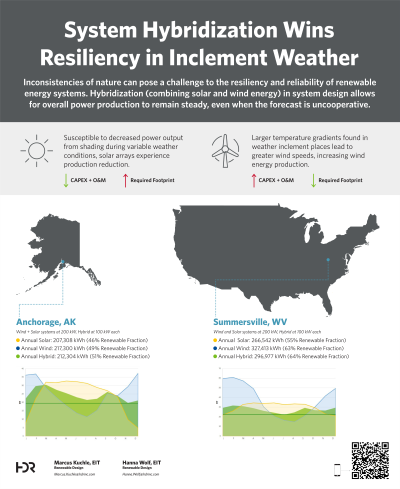Back

Managing Growth
Production Benefits of Hybrid Photovoltaic and Wind Systems in Regions that Experience Consistent Inclement Weather
Tuesday, September 12, 2023
4:30 PM - 5:30 PM PDT
Location: Poster Area, Booth #11024, Level 1, Venetian Expo Hall


Hanna Wolf, EIT-OR
Renewable Design EIT
HDR
Irvine, California, United States
Poster Presenter(s)
Reliability of a renewable energy system is one of the largest concerns and considerations associated to the utilization of the technology. The resiliency and reliability of these systems have continued to become of greater importance as the technologies further integrated into the grid. While the inconsistencies of nature can pose a challenge to the resiliency and reliability of renewable energy systems, hybridization of the system design allow for weaknesses to not waver overall power production. Consistent inclement weather, seen within cold weather climates, is a threat to the productivity of photovoltaic arrays. This variability in weather conditions introduce shading during crucial production hours of a day for photovoltaic arrays. In response to these challenges, the addition of a wind systems offers capitalization on the climate constraints felt by the solar technology.
Intermittencies between the two technologies can be resolved by combining their system strengths. During cold weather events, greater pressure differences lead to an increase in the production of wind. Higher temperature gradients associated with these events lead to greater wind speeds that can be favorable to wind turbine generator production. Given wind systems can thrive from this inclement weather, new de-icing technology within wind turbine design allows the system to withstand even lower temperatures. When the region is not experiencing inclement weather, solar irradiance will return to the expected values and the photovoltaic system will reappear as the primary system for power generation.
To ensure the resiliency and reliability desired by renewable system owners in cold weather climates, hybridization provides an answer to the hinderances of one system becoming key characteristics for increased performance by another. By developing familiarity, and subsequently more comfortability, with the technical capabilities of a hybrid renewable energy system there is opportunity for greater applications. Thus, increasing the allowed dependence on renewable technologies in regions where the systems would not have been originally considered by utilities and developers.
Intermittencies between the two technologies can be resolved by combining their system strengths. During cold weather events, greater pressure differences lead to an increase in the production of wind. Higher temperature gradients associated with these events lead to greater wind speeds that can be favorable to wind turbine generator production. Given wind systems can thrive from this inclement weather, new de-icing technology within wind turbine design allows the system to withstand even lower temperatures. When the region is not experiencing inclement weather, solar irradiance will return to the expected values and the photovoltaic system will reappear as the primary system for power generation.
To ensure the resiliency and reliability desired by renewable system owners in cold weather climates, hybridization provides an answer to the hinderances of one system becoming key characteristics for increased performance by another. By developing familiarity, and subsequently more comfortability, with the technical capabilities of a hybrid renewable energy system there is opportunity for greater applications. Thus, increasing the allowed dependence on renewable technologies in regions where the systems would not have been originally considered by utilities and developers.
